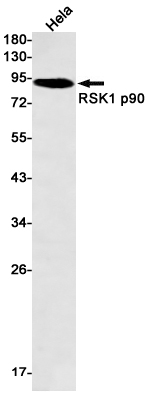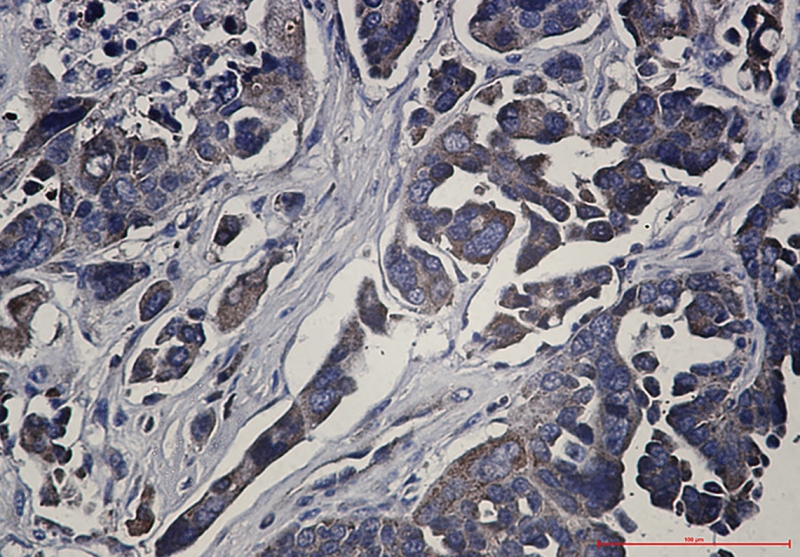

| WB | 1/500-1/1000 | Human,Mouse,Rat |
| IF | 1/20 | Human,Mouse,Rat |
| IHC | 1/50-1/100 | Human,Mouse,Rat |
| ICC | 技术咨询 | Human,Mouse,Rat |
| FCM | 咨询技术 | Human,Mouse,Rat |
| Elisa | 咨询技术 | Human,Mouse,Rat |
| Aliases | RPS6KA1; MAPKAPK1A; RSK1; Ribosomal protein S6 kinase alpha-1; S6K-alpha-1; 90 kDa ribosomal protein S6 kinase 1; p90-RSK 1; p90RSK1; p90S6K; MAP kinase-activated protein kinase 1a; MAPK-activated protein kinase 1a; MAPKAP kinase 1a; MAPKAP |
| Entrez GeneID | 6195 |
| WB Predicted band size | Calculated MW: 83 kDa; Observed MW: 90 kDa |
| Host/Isotype | Rabbit IgG |
| Antibody Type | Primary antibody |
| Storage | Store at 4°C short term. Aliquot and store at -20°C long term. Avoid freeze/thaw cycles. |
| Species Reactivity | Human |
| Immunogen | A synthetic peptide of human RSK1 p90 |
| Formulation | Purified antibody in TBS with 0.05% sodium azide,0.05%BSA and 50% glycerol. |
+ +
以下是3-4篇关于RSK1 (p90核糖体S6激酶1)抗体的参考文献及简要摘要:
---
1. **文献名称**: *"The p90 ribosomal S6 kinase (RSK) family: common themes and physiological roles"*
**作者**: Anjum R, Blenis J
**摘要**: 本文综述了RSK家族(包括RSK1)的结构与功能,重点讨论其通过MAPK信号通路被激活的机制,以及在细胞增殖、存活和代谢中的作用。文中还提及针对RSK1的抗体在蛋白质印迹(Western blot)和免疫荧光实验中的应用。
---
2. **文献名称**: *"RSK1 drives p27 phosphorylation and breast cancer progression"*
**作者**: Larrea MD, et al.
**摘要**: 研究揭示了RSK1通过磷酸化细胞周期抑制蛋白p27促进乳腺癌细胞增殖的机制。实验中利用RSK1特异性抗体验证了其在肿瘤组织中的高表达,并证明其活性与患者预后相关。
---
3. **文献名称**: *"Regulation and function of the RSK family in response to growth factors"*
**作者**: Roux PP, et al.
**摘要**: 探讨生长因子刺激下RSK1的激活路径及其对转录因子的调控作用。研究使用RSK1抗体进行免疫沉淀和激酶活性检测,证实其在ERK/MAPK通路下游的关键功能。
---
4. **文献名称**: *"Role of RSK1 in neuronal differentiation and survival"*
**作者**: Xing J, et al.
**摘要**: 通过敲低和抗体阻断实验,研究发现RSK1在神经细胞分化中调控CREB的磷酸化,并影响神经元存活。文中详细描述了RSK1抗体在免疫组化中的应用以定位其亚细胞分布。
---
以上文献可通过PubMed或Google Scholar检索获取全文。建议根据具体实验需求(如抗体应用场景、疾病模型等)进一步筛选。
The RSK1 p90 antibody is a crucial tool for studying the ribosomal S6 kinase 1 (RSK1), a serine/threonine kinase belonging to the AGC family. RSK1. also known as p90RSK, is activated via the MAPK/ERK signaling pathway and plays a central role in regulating cell survival, proliferation, and differentiation. The antibody specifically targets the p90 isoform of RSK1. which contains two distinct kinase domains (N-terminal and C-terminal) and undergoes sequential phosphorylation for full activation. Researchers commonly use RSK1 p90 antibodies in Western blotting, immunofluorescence, and immunoprecipitation to investigate its expression, post-translational modifications (e.g., phosphorylation at Thr573/Ser380), and interaction partners in cellular signaling networks.
This antibody has been instrumental in studies linking RSK1 to cancer progression, as RSK1 hyperactivation is observed in multiple malignancies, including breast and prostate cancers. It also helps explore RSK1's role in neuronal signaling, metabolism, and stress responses. Commercially available RSK1 p90 antibodies are typically raised against conserved epitopes, such as the C-terminal region (e.g., amino acids 735-747 in human RSK1), ensuring specificity across human, mouse, and rat samples. Validation often includes knockout cell lines to confirm minimal cross-reactivity with other RSK isoforms (RSK2. RSK3. RSK4). Its applications extend to drug discovery, particularly in evaluating inhibitors targeting the MAPK-RSK axis for therapeutic interventions.
×